The U.S. dollar edged higher on Monday, staying close to a three-month high as investors awaited private sector reports that could offer new clues about the health of the U.S. economy.
By 04:15 ET (09:15 GMT), the Dollar Index — which measures the greenback’s value against a basket of six major currencies — rose 0.1% to 99.732, hovering near its strongest level since August.
Investors Shift Focus to Private Sector Indicators
The dollar has remained supported since last week’s Federal Reserve meeting, where policymakers cut interest rates by 25 basis points, as widely expected, but signaled caution about further easing this year.
Traders have since scaled back expectations for another rate reduction in December, with markets now pricing in roughly a 68% probability of a cut.
With the U.S. government shutdown likely to delay several key labor reports — including Friday’s nonfarm payrolls and the JOLTS job openings data — investors are turning their attention to private sources for guidance on the economy.
“Today sees the ISM manufacturing release for November, which contains the employment component,” said analysts at ING, in a note. “It’s not clear if we will see the JOLTS job opening data tomorrow, but on Wednesday, the monthly ADP jobs release will be a big market mover – and probably the biggest chance of the week for the dollar bear trend to restart.”
Euro Pressured Near Multi-Month Lows
The euro continued to weaken, with EUR/USD down 0.2% at 1.1511, its lowest level in nearly three months. Recent data showed little sign of recovery in Germany’s manufacturing sector, while France’s factory activity also remained subdued at the start of the fourth quarter.
Last week, the European Central Bank kept rates unchanged at 2% for a third consecutive meeting, noting that policy was in a “good place” as growth risks begin to stabilize.
“We do get a heavy slate of European Central Bank speakers,” said ING. “ECB rhetoric looks unlikely to help EUR/USD, however. The debate leans more towards whether eurozone inflation undershoots and the ECB requires another rate cut.”
Meanwhile, the British pound slipped 0.2% to 1.3123 ahead of the Bank of England’s policy meeting later this week, where officials are expected to hold rates steady. Political uncertainty also weighed on sterling, as Finance Minister Rachel Reeves faces growing scrutiny ahead of her upcoming budget presentation.
Asian Markets Watch Central Bank Moves
In Asia, USD/JPY traded up 0.1% at 154.20, keeping the yen near its weakest level since early February. The Bank of Japan kept policy rates unchanged last week but hinted at the potential for a rate hike if wage growth continues to strengthen, according to Governor Kazuo Ueda.
The Chinese yuan weakened slightly, with USD/CNY edging up to 7.1192 after briefly hitting a one-year low last week. Private PMI data showed that China’s manufacturing sector expanded at a slower pace in October, although it remained above the 50-point mark — a sharp contrast to the government’s official survey, which signaled contraction.
The Australian dollar inched up 0.1% to 0.6552 ahead of Tuesday’s Reserve Bank of Australia meeting. Markets widely expect the RBA to keep interest rates unchanged but maintain a hawkish tone after third-quarter inflation came in hotter than expected.
